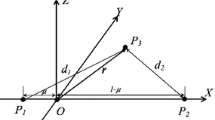Abstract
The purpose of this paper is the development of a procedure for the determination of constrained trajectories of spacecraft in the Solar System and its application to the computation of orbits, such as heteroclinic connections in the Sun-Earth-Moon system, that cannot be computed using only a two or three-body problem approach. Starting from a nominal trajectory computed in a simplified force model, the aim is to compute a new one, close to the original, but satisfying more realistic equations of motion. The formulation adopted allows for the existence of discontinuities in velocity and specific constraints for the states of the orbit, including boundary conditions. The continuity requirement of the orbit is accomplished in position by a differential correction process. The discontinuities in velocity are minimized using an optimization procedure. Some significant applications are presented, mainly regarding libration point orbit missions. It will be shown how using the initial input, the constraints and weights, an orbit, initially determined in the Circular Restricted Three–Body Problem, can be refined in order to fulfill the equations of motion of the Restricted n–Body Problem and specific scopes. In all the cases, an accurate initial guess is a key point.















Similar content being viewed by others
Notes
Here we simplify the notation in such a way that φ x ≡ φ(t i+1;t i , X i )|x .
References
Standish, E.M., Williams, J.G.: Orbital Ephemerides of the Sun, Moon, and Planets. available at. http://iau-comm4.jpl.nasa.gov/XSChap8.pdf
Alessi, E.M., Gómez, G., Masdemont, J.J.: Two-manoeuvres transfers between LEOs and Lissajous orbits in the Earth–Moon system. Adv. Space Res. 45, 1276–1291 (2010)
Canalias, E.: Contributions to Libration Orbit Mission Design Using Hyperbolic Invariant Manifolds. Ph.D. Thesis, Universitat Politécnica de Catalunya (2007)
Canalias, E., Masdemont, J.J.: Computing natural transfers between Sun-Earth and Earth-Moon Lissajous libration point orbits. Acta Astronaut. 63, 238–248 (2008)
Ocampo, C.A.: Architecture for a Generalized Spacecraft Trajectory Design and Optimization System. In: Proceedings of the Conference on Libration Point Orbits and Applications. Aiguablava Spain, June, World Scientific Publishing (2002)
Marchand, B.G., Howell, K.C., Wilson, R.S.: Improved corrections process for constrained trajectory n−body problem. J. Spacecr. Rocket.44, 884–897 (2007)
Alessi, E.M.: The Role and Usage of Libration Point Orbits in the Earth-Moon System. Universitat de Barcelona (2010)
Wäcter, A., Biegler, L.: On the implementation of an interior-point filter line-search algorithm for large-scale nonlinear programming. Math. Program. 106, 25–57 (2004)
Laird, C.,W¨acter, A.: Introduction to IPOPT: A tutorial for downloading, installing, and Using IPOPT (2006)
Gómez, G., Masdemont, J.J., Simó, C.: Quasihalo orbits associated with libration points. J. Astronaut. Sci. 46, 135–176 (1998)
Gómez, G., Llibre, J., Mart´ınez, R., Simó, C.: Dynamics and Mission Design Near Libration Point Orbits – Volume 1: Fundamentals: The Case of Collinear Libration Points. World Scientific, Singapore (2000)
Simo, C.: Solución del Problema de Lambert Mediante Regularización. Collect. Matemátic. XXIV, 231–247 (1973)
Szebehely, V.: Theory of Orbits. Academic Press, New York (1967)
Gómez, G., Jorba, A., Masdemont, J.J., Simó, C.: Dynamics and Mission Design Near Libration Point – Volume 3: Advanced Methods for Collinear Points. World Scientific, Singapore (2000)
Gómez, G., Mondelo, J.M.: The dynamics around the collinear equilibrium points of the RTBP. Phys. D. 157, 283–321 (2001)
Canalias, E., Cobas, J., Masdemont, J.J.: Impulsive transfers between Lissajous libration point orbits. J. Astronaut. Sci.51, 361–390 (2003)
Renk, F.: Mission Analysis for Exploration Missions Utilizing Near-Earth Libration Points. Ph.D.Thesis, Institute of Space System, Universität Stuttgart (2009)
Folta, D.,Woodard, M., Howell, K., Patterson, C.,Wayne, S.: Applications of Multi-Body Dynamical Environments: The ARTEMIS Transfer Trajectory Design. 61st International Astronautical Congress 2010, Paper ID: 7461 (2010)
Folta, D., Woodard, M., Pavlak, T., Haapala, A., Howell, K.: EarthMoon Libration Stationkeeping Theory, Modeling, and Operations. 1st IAA Conference on Dynamics and Control of Space Systems IAA-AAS-DyCoSS1, Paper ID: 05-10 (2012)
Acknowledgments
This work has been supported by the Spanish grants MTM2006–05849 (E.M.A., G.G.) and MTM2009–06973 and 2009SGR859 (J.J.M.) and by the Astronet Marie Curie fellowship MCRTN–CT–2006–035151 (E.M.A.). We also acknowledge the use of the UPC Applied Math cluster system for research computing (see http://www.ma1.upc.edu/eixam/index.html).
Author information
Authors and Affiliations
Corresponding author
Rights and permissions
About this article
Cite this article
Alessi, E.M., Gómez, G. & Masdemont, J.J. A Methodology for the Computation of Constrained Orbits and its Application to the Design of Solar System Trajectories. J of Astronaut Sci 59, 477–501 (2012). https://doi.org/10.1007/s40295-014-0004-2
Published:
Issue Date:
DOI: https://doi.org/10.1007/s40295-014-0004-2




